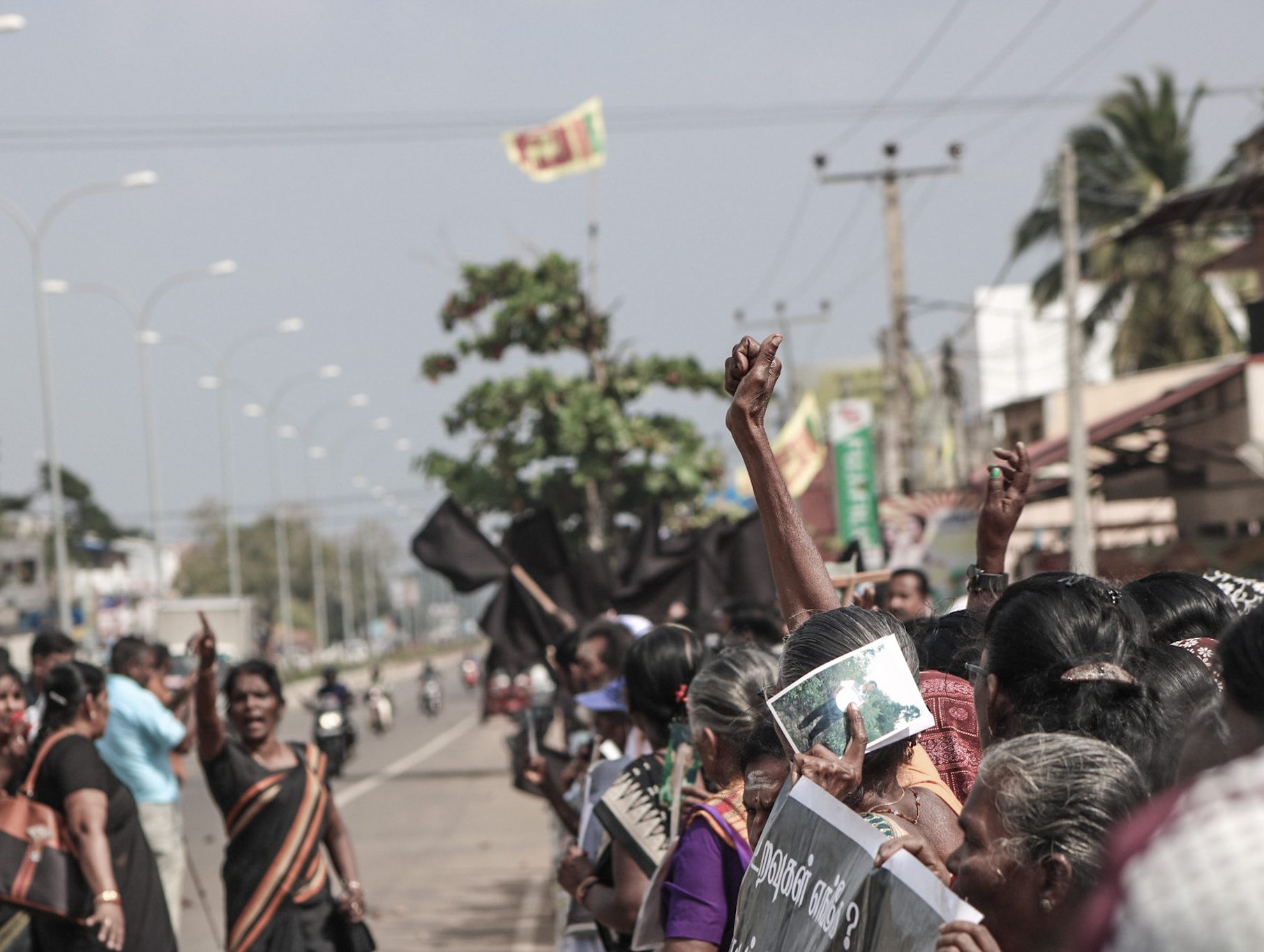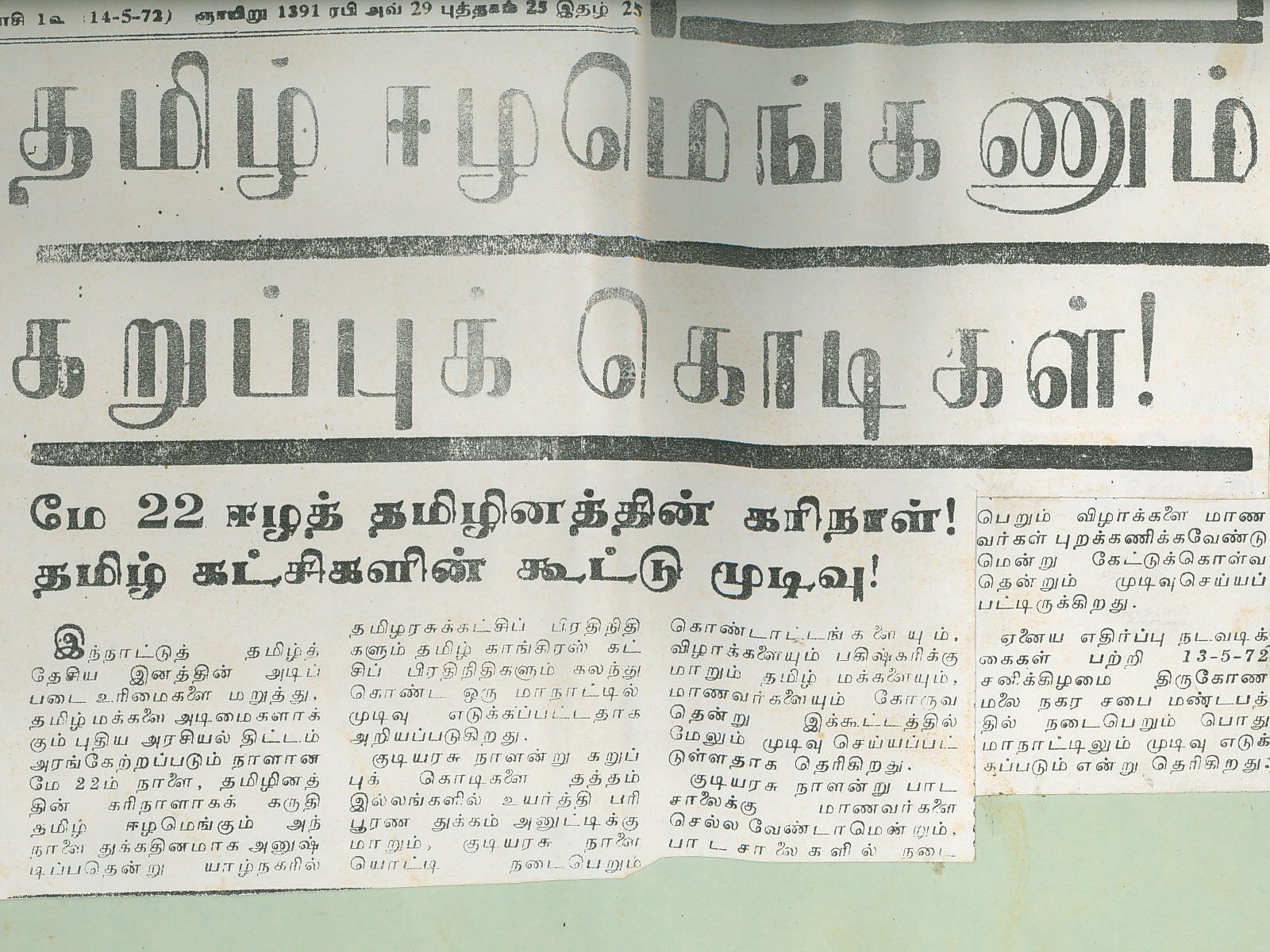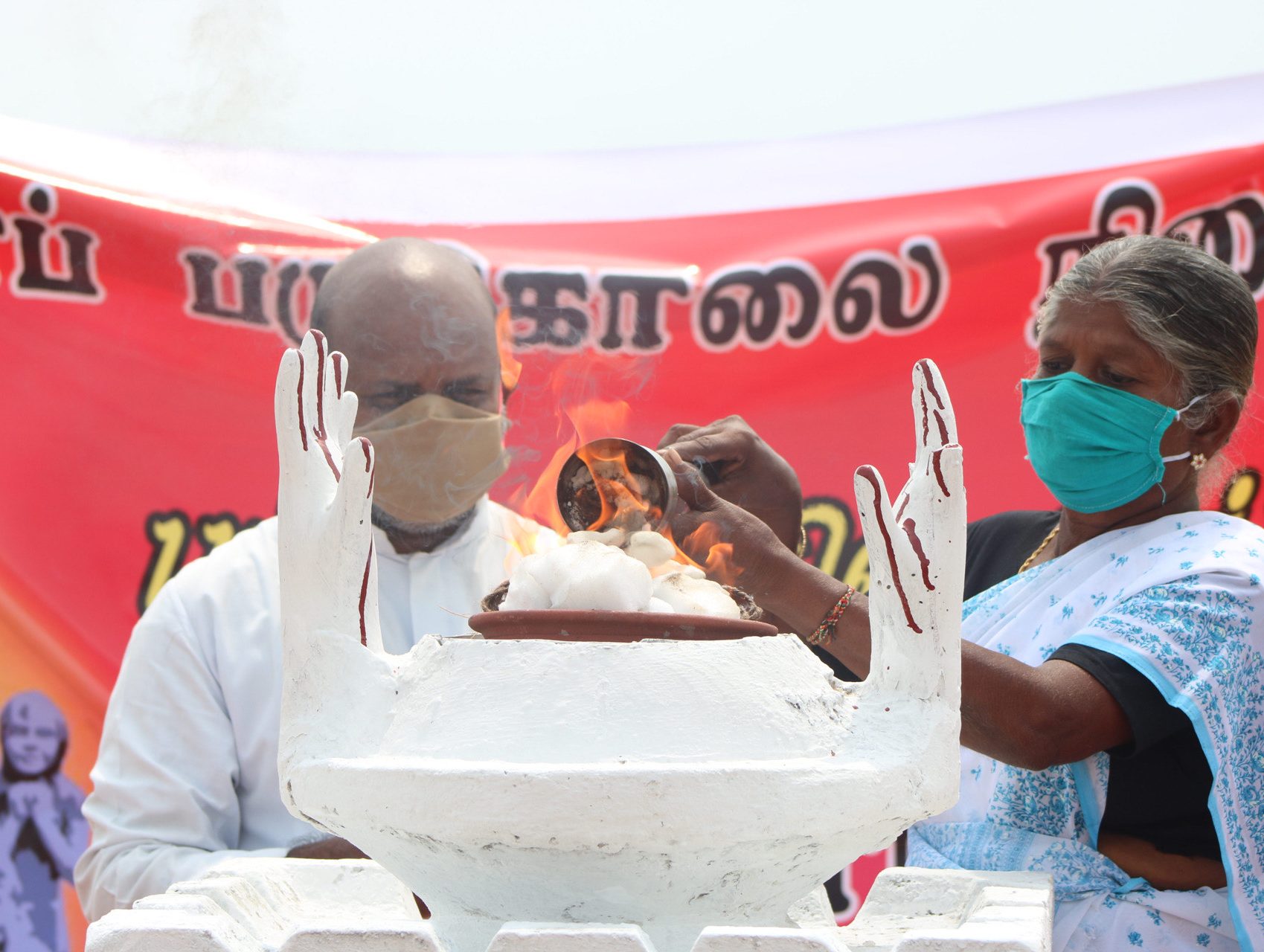
Tamil protest with black flags in Kilinochchi during Sri Lankan Independence Day on February 4, 2020. Photo: Kanapathipillai Kumanan
In November 2019 Sri Lanka again produced headlines in the international media. Gotabhaya Rajapakse won the presidential elections by a landslide. Shortly afterwards, he appointed his brother and former president Mahinda Rajapakse as prime minister. Thus, the Rajapakse brothers are back in power after five years. In May 2009 they had conquered the last territories of the LTTE (Liberation Tigers of Tamil Eelam). The author outlines what this return means from a Tamil perspective.
To this day, the Sri Lankan government boasts of having defeated "terrorism" on May 18, 2009. But this day is only celebrated in the Sinhala part of the country. With pompous military parades and a gathering of the political and economic elite of this part of the country. In the North-East of the island however, the traditional homeland of the Tamils, May 18 is a day of mourning. Here the tens of thousands of Tamils who were killed in the last months of the armed conflict in 2009 are remembered. Though, both the LTTE and the Sri Lankan government are accused of war crimes, but the vast majority of deaths are attributed to the actions of the Sri Lankan military. (for more information on the alleged war crimes see the ECCHR article in the issue).
Tamil commemoration ceremonies have been obstructed in the past by the police or military. Also in 2020 the Sri Lankan security forces had disrupted the commemoration ceremonies on May 18 with the argument, that events could not be held because of the coronavirus pandemic. The few participants were threatened with arrest or photographed, although they had worn protective masks and kept a safe distance. However, the same rules did not seem to apply to the government. One day later, the Rajapakses celebrated the War Heroes' Day with hundreds of participants in a military ceremony in Battaramulla, Colombo.
War criminals in the fight against the pandemic
The coronavirus did not stop at Sri Lanka. Unlike in many other countries, where the management of the pandemic is led by scientists and health authorities, the Sri Lankan government took a militaristic approach - led by an army that is accused of serious human rights violations. In Sri Lanka, the coronavirus response is being managed by the specially appointed Presidential Task Force on COVID-19. Head of this task force is Shavendra Silva, currently the army chief and former commander of a unit in 2009 with a long list of atrocities. Silva's appointment as army chief last year was strongly condemned by numerous activists, states and the UN High Commissioner for Human Rights. The USA recently banned Silva from entering the country because of these credible accusations.
The "fight" against the virus is often compared to the war against the LTTE and its destruction. The current secretary of the Ministry of Defence, Kamal Gunaratne, makes use of this martial language even comparing the current situation with 2009, when "the whole country got together to defeat terrorism”. Gunaratne has a past similar too Silva. The investigation report of the UN High Commissioner's Office (OISL) and dossiers of the human rights organisation ITJP (International Truth and Justice Project) indicate that the division under Gunaratne's leadership also committed numerous human rights violations in 2009.
Instead of coming to terms with these atrocities and bringing those responsible to justice, the accused are rewarded with senior posts in the military or diplomatic missions. The military is regularly praised by Sinhala leaders of all major parties and the culture of impunity is publicly defended. The political will to deal with these crimes is completely missing.
Covid-19 conceals systematic rollback
Therefore, a ruling in 2015 surprised the Tamil population. In the village of Mirusuvil in the north of the island, 20 years ago, Sri Lankan soldiers cut the throats of eight Tamils, including three children, and threw them into a mass grave. The youngest child was five years old. A Tamil witness was able to identify five of the soldiers. After a long trial one of them, Sunil Rathnayake, was found guilty by a court in 2015. Human rights organisations and diplomats were also surprised by the conviction. In the history of Sri Lanka, a Sri Lankan soldier has rarely been convicted for such crimes against the Tamil people.
But in the midst of the coronavirus turmoil, President Rajapakse pardoned the convicted Rathnayake and ordered his release. In the south of the country, this act was welcomed by Sinhala politicians, even by the opposition. Rajapakse promised during his election campaign last year that he would pardon and release "war heroes". In his opinion, they have been accused with groundless accusations. Rathnayake's pardon, on the other hand, has been strongly condemned by the Tamil population and human rights organisations. Kumaravadivel Guruparan, law professor at Jaffna University, called the pardon "not surprising but utterly disgusting - in the middle of a crisis furthering the politics of Sinhala Buddhist nationalism".
Sinhala Buddhist nationalism
It is precisely this Sinhala Buddhist nationalism that feeds the structures of the Sri Lankan state. The ideology and belief that the Sinhala people are superior to the other people in Sri Lanka often originates from racist and anti-Tamil mythologies and is not just a marginal phenomenon, but the major driving force in the country. This belief is supported by influential and extremist Buddhist monks.
Already after the independence of Sri Lanka (then Ceylon) in 1948, it quickly became clear that the Sinhala majority would use the newly acquired power over the entire island to the detriment of the minorities, above all the Tamil population. Just one year later, the Sinhala government stripped all political and civil rights from the more than one million Indian Tamils who had been working in the plantations in the centre of the island during western colonisation. In 1956, the Sinhala-Only Act decided that Sinhala alone would become the official language of the country. Over the years there have been several such laws which have discriminated strongly against the Tamil population. With the constitutional amendment of 1972, "Ceylon" was renamed "Sri Lanka", a name of Sinhala origin. The new constitution assigned Buddhism the "foremost place" in the country. The state was and still is obliged to promote and protect Buddhism. Sinhala Buddhism is also present in many other areas of the state, from the lion flag to the unitary state structure to the almost exclusively Sinhala recruited military.

Headline in a 1972 Tamil newspaper documenting the call of the Tamil parties to protest against the new Sinhala Buddhist constitution "Black flags all over Tamil Eelam!, May 22 is a black day for the Eelam Tamil people!"
Resistance, repression, struggle
The Tamil population did not tacitly accept this development. Since the beginning of independence there has been public resistance. The introduction of the lion flag, for example, was criticised by Tamil politicians, as the lion literally and historically represents only the Sinhalese. Numerous peaceful protests and sit-ins were organised against discriminatory laws, and black flags were hoisted on Sri Lankan holidays as a sign of resistance to the Sinhala Buddhist unitary state.
The peaceful resistance of the Tamil people, led by the Federal Party, was consistently crushed. The Sinhala population was incited and supported by Sinhala politicians of all parties and the security forces. In anti-Tamil riots and pogroms hundreds to thousands of Tamils were killed in 1956, 1958, 1977, 1981 and 1983. Just in 1983 more than 3000 Tamils died, hundreds of thousands fled from the Sinhala areas to the Tamil North-East or abroad.
The decades of oppression and discrimination against the Tamil population in turn encouraged the rise of Tamil nationalism, which aimed at the self-determination of the Tamil people. While the initial demands were for equal rights, decentralisation and federalism, the anti-Tamil pogroms and unsuccessful political efforts fueled the demand for a separate Tamil state. This demand was initially a public part of Tamil politics. However, under the keyword of separatism, this policy approach was banned and countered by the Sri Lankan state with draconian measures.
The Tamil youth, who were discriminated against especially in the area of education, saw no hope in a political solution and resorted to armed resistance as a means of change. This was followed by an extremely brutal and almost 30-year long armed conflict between the Sri Lankan state and the Tamil militant organisation LTTE. The LTTE was committed to the separate Tamil state. Numerous states were directly or indirectly involved in the conflict, always on the side of the Sri Lankan state.
The armed conflict ended in 2009 with the massacre in Mullivaikkal, which many Tamils consider a genocide against the Tamil people. The UN Human Rights Council adopted an investigation and reappraisal of the war crimes in 2015 on the basis of the OISL report (Resolution 30/1). Although the previous Sri Lankan government supported this resolution, it has consistently denounced the process of accountability and justice publicly. The current government has even completely withdrawn from the resolution. President Rajapakse has recently threatened to withdraw from all international organizations that make Sri Lanka's "war heroes" vulnerable to attacks.
Resist
In Sri Lanka, the refusal for justice and accountability is often justified by the argument that the armed conflict is over and one must now "look forward". Often the word "reconciliation" is used, accompanied by pictures showing happy Sinhala, Muslim and Tamil children. Western governments are also happy to use this image, justifying their economic and political support for Sri Lanka as a contribution to the reconciliation process. But the harmonious picture is deceptive. For many Tamils, reconciliation without the accountability of the state and justice for the numerous victims is only an illusion.
Whether in the diaspora or on the island, many Tamil people protest for justice. Perhaps most impressive is the protest of the Tamil families of the disappeared whose partners, children or siblings disappeared without trace during the final phase of the war, often in the custody of the Sri Lankan army. Many of them have been protesting under precarious conditions for over 1000 days for justice, against the inaction of the international community and in the hope that the Sri Lankan state will finally clarify and account for the whereabouts of their relatives. Under pressure from the international community, the previous government set up an Office of Missing Persons, but it is overwhelmed by the countless cases of disappearances.
Authoritarian politics through the pandemic
In the context of the COVID-19 pandemic, the Government of Sri Lanka has set up further task forces. They have been given excessive powers and are intertwined with family members and friends of the Rajapakses, the military and parts of the private sector. At the same time, dozens of civilian ministries and institutions have been placed under the Ministry of Defence, which is de facto controlled by the President. Since the parliament, which is supposed to control the government, was dissolved and will only be reconvened after the elections, power has been concentrated on the president and his inner circle.
Two of the task forces are particularly worrying in this respect. One is responsible for the "archaeological heritage" in eastern Sri Lanka. Under the guise of "archaeological research" or "development", attempts have been made in the past to change the population distribution in the North-East of Sri Lanka, which is the traditional homeland of the Tamil and Muslim population. For example, new Sinhala settlements are being supported by the state, villages are being renamed, Tamil and Muslim land is being occupied by the military, and numerous Buddhist temples are being built. The Tamil population in the east has been declining sharply for decades, while the Sinhala population has increased dramatically. With the new task force, which is exclusively staffed by Sinhalese, fears are growing that the Sinhalization of the North-East is continuing. The other task force with very vague competences is supposed to contribute to the establishment of a "disciplined, virtuous and lawful society". It is composed exclusively of military and police officials, including Shavendra Silva, Kamal Gunaratne and others charged with serious war crimes.
Sri Lanka has long been a dangerous place for journalists and human rights defenders. After the election defeat of the Rajapakses in 2015, a small space opened up for Tamil civil society and the diaspora to publicly criticise the government and organise dissent. But this phase is over. For months now, attacks and intimidations against people critical of the government have been increasing again. The situation could worsen with the second new task force. The vague formulations allow for extensive interventions, even against "anti-social activities" from abroad. The undermining of the separation of powers, the transfer of authority to the military, the restrictions and intimidation of Tamil civil society and the diaspora are not only alarming the Tamil population but also numerous Muslim and Sinhala activists, human rights organisations and journalists critical of the government. They all fear that Sri Lanka could turn into an autocratic state in the foreseeable future.
Defending Tamil interests
For the Tamil population the signs are worse than ever before. The Sinhala Buddhist unitary state is growing stronger, the militarisation of the North-East is being normalised and at the same time the Tamil opposition is in a weak state. The hope that the Tamil people will receive justice for the crimes they have suffered and that those responsible will be brought to justice is dwindling from year to year. Nonetheless, Tamil activists and human rights defenders are working hard at the United Nations, with Western governments and other decision-makers to ensure that their policies towards Sri Lanka respect Tamil interests and finally hold the Sri Lankan state accountable. Exhibitions, film screenings, reading groups and social media campaigns are organised by Tamil youths to raise awareness of the problems. In Sri Lanka, Tamil students organise protest and commemoration events that are regularly banned, Tamil activists and journalists defy intimidation by the security forces. The protests of the Tamil families of the disappeared also continue.
And on official holidays, such as the Sri Lankan Independence Day on 4 February, black flags are waving in the North-East of the island.

Remembrance event on 18 May 2020 in Mullivaikkal, where tens of thousands of Tamils were killed 11 years ago. Photo by Kanapathipillai Kumanan
About the author:
Sagi Thilipkumar is a law student in Zurich and the Advocacy Coordinator Switzerland for the non-profit organization People for Equality and Relief in Lanka (PEARL) from Washington-DC.
This piece was originally published in the “Südasien” magazine 2/2020, in German.
